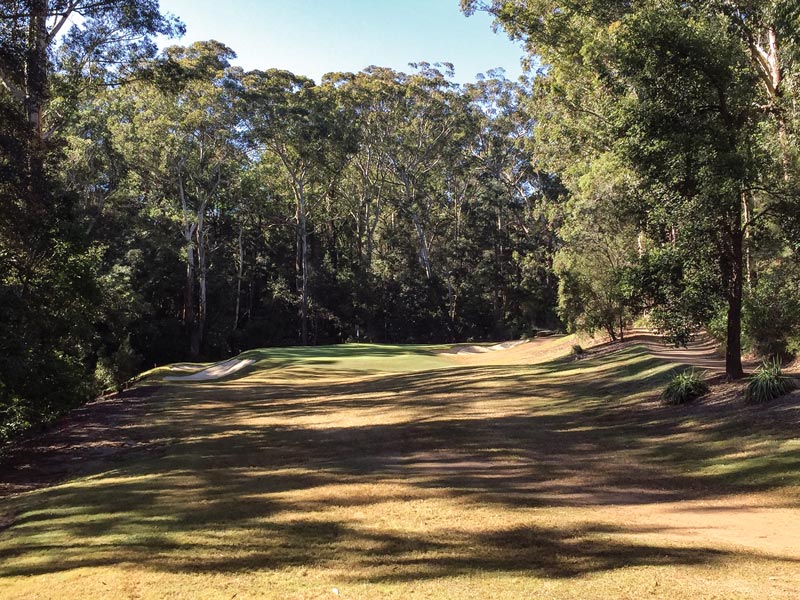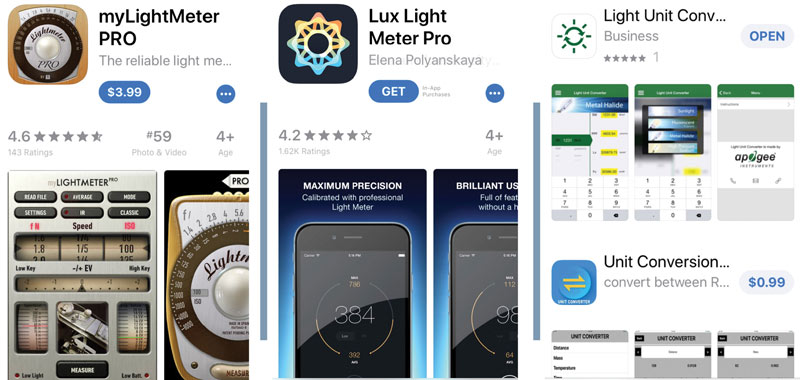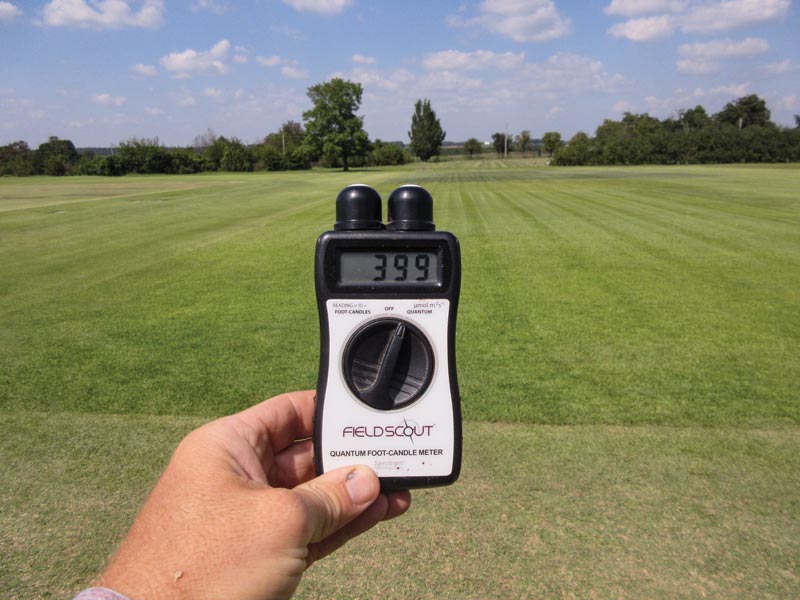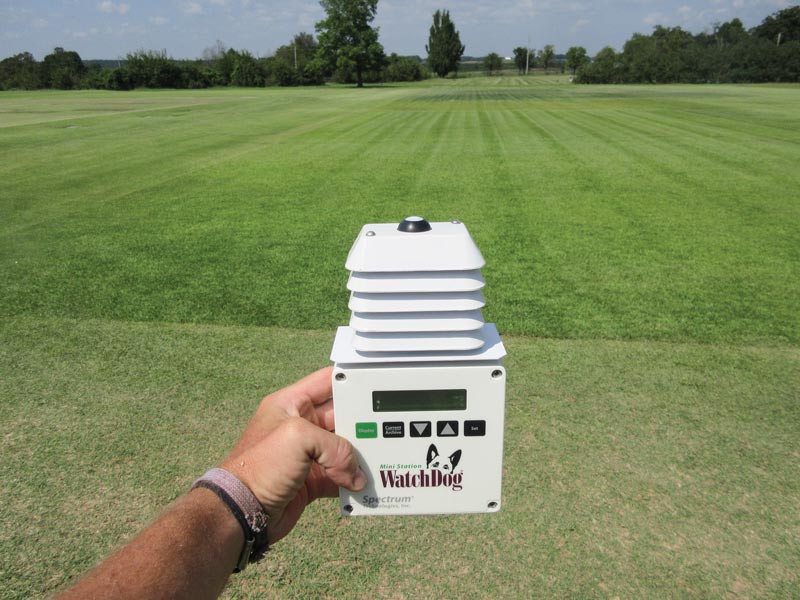
Shade problems are clearly affecting all parts of this golf hole, from tee to green. Photo by Mike Richardson
Shade can be one of the most delicate issues that a golf course superintendent has to deal with. To the superintendent, it probably seems ridiculous to think that one of the most important raw ingredients that turfgrass needs — light — would be minimized in any way. However, shade is usually caused by trees, which can be sacred objects on many courses. As such, removing trees from the strategy or beauty of a specific hole may also seem equally ridiculous to golfers or club management. Feelings can run high on both sides of the tree removal decision, so using technology and data can help eliminate emotion from the process.
Measuring light on the golf course
Over the past decade, researchers, consultants and turf managers have been using technology to accurately measure light levels on a particular site and then relate those measurements to the light needed for that specific grass.
The sunlight needed by plants for photosynthesis comes from very narrow bandwidths in the red and blue range (wavelengths of 400 to 700 nanometers). This light is commonly called “photosynthetically active radiation,” or PAR. There are many other types of light that strike the turf, such as infrared or ultraviolet radiation, but photosynthesis requires PAR to create energy for the plant.
There are lots of ways to measure light, but in order to understand how light affects plant growth and health, we need to use a device that will specifically measure PAR. You may have seen a photographer use a light meter before shooting a picture, but those meters measure total light and will not separate PAR from other forms of radiation.
There are apps for your phone that can use your phone camera to measure total light intensity. Although measurement of total light with your phone or a light meter can give you an estimate of how much shade is at a site, the measurement of actual PAR will always provide a more accurate representation of how shade affects plant growth.
Recently, we discovered an app called Light Unit Converter (App Store, Google Play) that will convert the total light units collected with your phone (usually reported in watts/square meter) to PAR (reported in µmol/square meter/second). See “Measuring the daily light integral,” below, for more information about units of measurements for light.
It should be cautioned that, while those conversions will work pretty well if you are measuring light in full sun, they may underestimate PAR in a tree-shaded site. The units of PAR can also be a little daunting, as none of us think about a µmol of energy very often. However, the more important thing to understand is that the measurement is calculated “per sec,” which means that the turf is receiving a unique amount of energy every second that the sun is shining.

Various apps are available for your phone to measure light (left, center) and convert those light measurements to units of photosynthetically active radiation, or PAR (right).
Shown, from left to right, are myLightMeter PRO (App Store, Google Play), Lux Light Meter Pro (App Store), and Light Unit Converter (App Store, Google Play).
Quantum meters are designed to measure just the radiation in the PAR range and will filter out the other forms of light that a standard light meter measures. This is really important, as trees also need PAR for photosynthesis, so the light that passes through a tree will have a lot of the PAR already removed.
Over the course of a day, a site will receive varying amounts of light depending on the angle of the sun (low light at dawn and high light at noon) and the impact of objects such as trees or mountains.
In order to account for these changing light conditions, we need to measure how much light the plant has available for photosynthesis over the entire day. This total amount of light is now commonly referred to as the daily light integral (DLI) and is expressed in mol PAR/square meter/day.
Measuring PAR can be accomplished with a range of meters, some of which have data loggers that can be left at a site to collect data for an entire day. Others, which are hand-held, require collecting measurements throughout the day and then processing that data to calculate the DLI. We have developed a simple DLI calculator spreadsheet that can be used to enter data collected over the course of a day to calculate the DLI.
Is the light adequate for turfgrass?
Now that we can measure how much light an area is receiving, the next most obvious question is whether there is enough light to grow bermudagrass or tall fescue or some other turfgrass species.
Numerous research groups across the country have been working diligently to define the critical amount of light that a specific grass needs to produce an acceptable level of quality, whether for a lawn, a sports field or a putting green. These studies are confirming some of the things we already know about shade, such as: Cool-season grasses require less light than warm-season grasses; raising the mowing height reduces the light requirement; and using plant growth regulators can reduce the light needed by the turf.
However, the most critical information that is coming from this research is that a minimum light requirement — the daily light integral — is being established for each species or even each cultivar of turfgrass. See the table Minimum daily light integral (DLI) requirement of various turfgrasses. Although not complete, there is enough information in the table to allow a superintendent to start identifying a target light requirement that is needed to sustain a bentgrass green or a zoysiagrass tee.
Just as a point of reference, a full sunny day in midsummer in Arkansas provides a DLI of about 45 mol/square meter/day.


Examples of quantum light sensors that measure PAR in µmol/square meter/second. Some devices collect instantaneous, single measurements (top), while other have data loggers (bottom) that can be placed at a site to collect data over a longer period of time. Photos by John McCalla
Turfgrass managers now have several options available to them to measure the amount of PAR that a site is receiving each day. This allows a manager to make a much stronger argument for changing grasses or removing trees that are causing decline in the turf. As researchers continue to quantify how much light is needed to sustain turfgrass species under varying management practices, turf managers will be able to either select a more appropriate grass for a shaded site or make modifications to the site to improve turf conditions.
Remember, if you can measure it, you have a much better chance of modifying it.
Measuring the daily light integral
Photosynthetically active radiation (PAR) is measured in µmol/square meter/second. Full sun in the middle of the day will produce around 2,000 µmol/square meter/second. A µmol is a unit of energy, just as inches are a unit of length. Over a full day, each second has a unique amount of PAR, so to calculate the total light for the day, you have to add together those ~50,000 (14 hours × 60 minutes × 60 seconds) unique energy measurements to get the daily light integral, which is reported in mol/square meter/day. There are 1,000,000 µmol in 1 mol of PAR.
Literature cited
- Bunnell, B.T., L.B. McCarty, J.E. Faust, W.C. Bridges and N.C. Rajapakse. 2005. Quantifying a daily light integral requirement of a ‘TifEagle’ bermudagrass golf green. Crop Science 45:569-574.
- Chhetri, M., C. Fontanier, K. Koh, Y. Wu and J.Q. Moss. 2019. Turf performance of seeded and clonal bermudagrasses under varying light environments. Urban Forestry & Urban Greening 43:126355. doi.org/10.1016/j.ufug.2019.05.017
- Glenn, B. 2015. Effect of shade intensity and duration on warm-season turfgrass growth and development. Ph.D. dissertation, University of Florida.
- Richardson, M.D., G. Mattina, M. Sarno, J.H. McCalla and D.E. Karcher. 2019. Shade effects on overseeded bermudagrass athletic fields: I. Turfgrass quality, coverage, and growth rate. Crop Science (in press).
- Russell, T.W., D.E. Karcher and M.D. Richardson. 2019. Daily light integral requirement of a creeping bentgrass putting green as affected by shade, trinexapac-ethyl, and a plant colorant. Crop Science 59:1768-1778. doi:10.2135/cropsci2018.08.0501
Mike Richardson is a professor, Doug Karcher is a turfgrass soil specialist and professor, and Daniel O’Brien is a program technician in the Department of Horticulture at the University of Arkansas in Fayetteville, Ark.